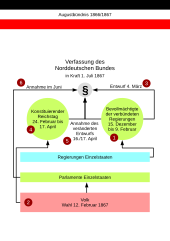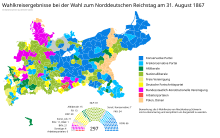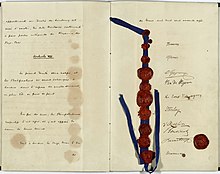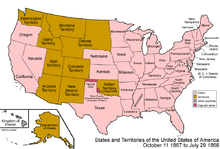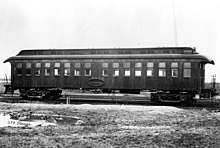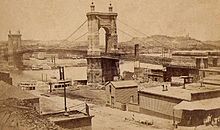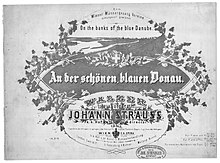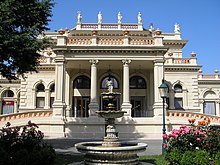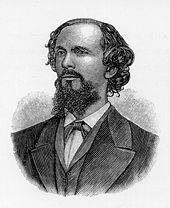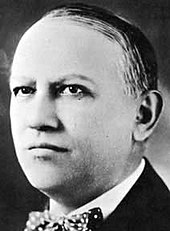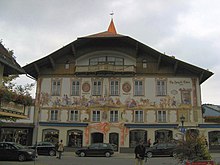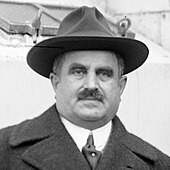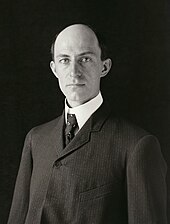1867
Portal History | Portal Biographies | Current Events | Annual Calendar | Article of the day
◄ |
18th Century |
19th Century
| 20th Century
| ►
◄ |
1830s |
1840s |
1850s |
1860s
| 1870s
| 1880s
| 1890s
| ►
◄◄ |
◄ |
1863 |
1864 |
1865 |
1866|
1867
| 1868
| 1869
| 1870
| 1871
| ►
| ►►
| 1867 | |
|---|---|
| Franz Joseph I and his wife Elisabeth become the royal couple of Hungary after the Austro-Hungarian Compromise . | |
|
The first volume of Karl Marx 's Capital is published. |
The waltz On the beautiful blue Danube by Johann Strauss (son) is heard for the first time in the Dianabad . |
|
The Russian Empire sells Alaska to the United States in the so-called Alaska Purchase . |
|
| 1867 in other calendars | |
| Armenian calendar | 1315/16 (July turn of the year) |
| Ethiopian calendar | 1859/60 (11/12 September) |
| Baha'i calendar | 23/24 (20/21 March) |
| Bengali solar calendar | 1272/73 (beginning of the year April 14 or 15) |
| Buddhist calendar | 2410/11 (Southern Buddhism); 2409/10 (alternative calculation according to Buddha's parinirvana ) |
| Chinese calendar | 76th (77th) cycle
Year of the Fire Rabbit 丁卯 ( at the beginning of the year Fire Tiger 丙寅) |
| Chula Sakarat (Siam, Myanmar) / Dai calendar (Vietnam) | 1229/30 (April New Year) |
| Dangun era (Korea) | 4200/01 (October 2nd/3rd) |
| Iranian calendar | 1245/46 (around March 21) |
| Islamic calendar | 1283/84 (4/5 May) |
| Jewish calendar | 5627/28 (29/30 September) |
| Coptic calendar | 1583/84 (11/12 September) |
| Malayalam calendar | 1042/43 |
| Rumi Calendar (Ottoman Empire) | 1282/83 (March 1) |
| Seleucid era | Babylon: 2177/78 (April turn of the year)
Syria: 2178/79 (October turn of the year) |
| Vikram Sambat (Nepalese calendar) | 1923/24 (April) |
In 1867 , the North German Confederation , founded the previous year, was transformed from a military alliance into a federal state by means of a constitution passed by a newly elected constituent Reichstag . Otto von Bismarck is appointed Chancellor .
The Habsburg monarchy also experienced a constitutional restructuring: the Austro-Hungarian Compromise transformed the former Austrian Empire into the dual monarchy of Austria-Hungary . At the end of the year, the December constitution came into force in the Austrian half of the empire ( Cisleithania ) , which contained a catalog of basic rights with the basic law on the general rights of citizens .
There are also revolutionary developments in other parts of the world: in Japan , the last shogun of the Tokugawa shogunate formally abdicates under pressure from the reformers striving for a restoration of imperial rule . The Edo period ended and the Meiji period began with the accession of 14-year-old Mutsuhito to the throne . The execution of Emperor Maximilian I of Mexico by Republican troops of President Benito Juarez ended the short-lived 2nd Empire of Mexico . A few days later, the Canadian Confederation gained independence from Great Britain .
The Russian Empire signs a treaty with the United States for the sale of approximately 1.6 million km² of what is now the state of Alaska .
events
politics and world affairs
| chronology | |
|---|---|
| Ongoing Events | |
| Rotativismo in Portugal (since 1856) | |
| Nian Rebellion (since 1853) against the Qing Dynasty in China (since 1644) | |
| Second Empire in France (since 1852) | |
| Gründerzeit in Germany and Austria (since about 1840) | |
| Tanzimat reforms in the Ottoman Empire (since 1839) | |
| Victorian era in Britain (since 1837) | |
North German Confederation
- February 7: The allied governments of the North German Confederation agree on a draft constitution proposed by Otto von Bismarck , which is to be presented to a Reichstag that has yet to be elected. On February 19, Bismarck presented the governments with a secret alternative draft if the Reichstag rejected the first draft or changed it too much. In this case, the constitution should be imposed as a state treaty.

- February 12: Based on the August treaties of 1866, the general election for the constituent Reichstag for the North German Confederation is carried out according to universal suffrage . The necessary run-off elections will take place in the weeks that follow . The member states of the North German Confederation have been divided into 297 constituencies for the election, 236 of which are in Prussia . The Kingdoms of Bavaria and Württemberg , the Grand Duchy of Baden and the southern part of the Grand Duchy of Hesse do not belong to the North German Confederation and therefore do not take part in the election. The electoral laws of the individual states, which are based on the Frankfurt Reichstag Elections Act of 1849, apply to the election. After the Reichstag elections in February 1867 , the National Liberal Party together with the liberal-conservative Free Conservatives had the majority . Both parties work together with Otto von Bismarck . Especially in the provinces of Schleswig-Holstein and Hanover , which were annexed by Prussia in 1866 , federal constitutional candidates achieved electoral successes. The Saxon People's Party , partly a forerunner organization of the later Social Democrats , moves into the body with two deputies.

- February 24: The constituent Reichstag holds its first session. August Bebel is the first German social democrat to belong to a constitution - making assembly. Eduard von Simson becomes President of the Reichstag, whose task it is to agree on a constitution for the North German Confederation .
- March 4: The governments' draft constitution is presented to the constituent Reichstag.
- March 19: The protection and defiance alliances concluded the previous year between Prussia on the one hand and the southern German states of Bavaria , Württemberg and Baden on the other hand are published. Another alliance follows with the Grand Duchy of Hesse .
- March 27: The Lex Bennigsen introduces the ministerial responsibility of the Federal Chancellor . The National Liberal deputy Rudolf von Bennigsen introduced an amendment that adjusted the draft constitution discussed by the constituent Reichstag .
- April 16: The constituent Reichstag accepts Bismarck's draft constitution with the changes decided upon. The plenipotentiaries of the states accepted the amended draft on the same day.

- Between June 21st and June 27th, the individual states put the federal constitution into force through publication patents.
- July 1: The constitution of the North German Confederation comes into force. This completes the founding of the North German Confederation as a federal state .
- July 8: The German Customs Union is newly regulated by law. For the first time, the new customs union has federal institutions such as the Federal Customs Council and a customs parliament as legislative bodies. The majority decisions taken by these bodies are binding for all member states; there is no longer a veto. The executive body is the Prussian King's Customs Board. The law comes into effect on January 1, 1868.
- July 14: King Wilhelm of Prussia , in his capacity as holder of the Federal Presidency , appoints the Prussian Prime Minister Otto von Bismarck as Federal Chancellor .
- August 12: Chancellor Otto von Bismarck sets up the Federal Chancellery of the North German Confederation. It is responsible for the internal affairs of the Confederation. President of the Chancellery and Bismarck's right-hand man becomes Rudolph von Delbrück .
- August 31: Turnout in the Reichstag election in August 1867 is lower than in the February election. The necessary runoff elections will take place in the following weeks. The political balance of power after the election remains essentially unchanged. The North German Confederation now has its parliament.
- 1 November: The Freedom of Movement Act is passed.
- November 9: The Navy of the North German Confederation is founded by federal law, which emerges from the Prussian Navy . The other member states in the North German Confederation do not have their own naval forces, but are obliged to pay contributions and to provide personnel. Nevertheless, the North German Federal Navy is still subordinate to the Prussian Navy Ministry.
Austria-Hungary
- February 1: Richard Belcredi , representative of a federalist settlement with all nationalities of the multi-ethnic Austrian state, submits his resignation request after the meeting of the Council of Ministers.

- February 7: Emperor Franz Joseph I appoints Friedrich Ferdinand von Beust Prime Minister of Austria .
- February 17: King Franz Joseph I appoints former revolutionary Count Gyula Andrássy as Prime Minister of Hungary . February 18th sees the restoration of the 1848 Constitution with few changes. Two days later Andrássy presents his government. Transylvania and the Banat are reunited with Hungary.
- February 27: The Hungarian Reichstag , dissolved after the Hungarian Revolution , is reestablished as part of the Austro-Hungarian Compromise . It replaces the state parliament that existed twice in between .
- March 15: With the signing of the Austro-Hungarian Compromise , the dual monarchy of Austria-Hungary is founded . The Andrássy government takes the oath of allegiance to Franz Joseph I in Buda .
- 8 June: The Austro-Hungarian settlement comes to a festive conclusion with the ceremonial coronation of Emperor Franz Joseph I and his wife Elisabeth as the Hungarian royal couple . The Magyars are reconciled with the House of Habsburg . Under the Andrássy government, a new peak in Magyarization began in the Hungarian half of the empire.
- 21 December: Emperor Franz Joseph I sanctions the December Constitution , which goes into effect the next day. The associated Basic Law on the general rights of citizens contains a catalog of basic rights based on the model of the imposed March Constitution of 1849, which is still largely valid in Austria today.
- December 30: Karl von Auersperg becomes the new Prime Minister of Cisleithania . His government was called the Citizens' Ministry because of the majority of its members .
Other events in Europe
- 1 January: Constant Fornerod becomes Federal President of Switzerland for the third time .
- April 18: The last Ottoman fortress commander leaves the Principality of Serbia under pressure from Prince Mihailo Obrenović ; the capital is moved from Kragujevac to Belgrade , marking the end of 346 years of Ottoman rule in Belgrade .
- May 7th to 11th: In the London Treaty , the Luxembourg crisis around the intended purchase of the Grand Duchy of Luxembourg by the French government under Napoléon III. of the Netherlands under King William III. settled: France does not acquire Luxembourg, but Prussia withdraws its garrison from the fortress in Luxembourg City and this is destroyed. Luxembourg is to remain neutral in future conflicts and is declared independent.
- 26 June/1 July: Portugal is one of the first countries in Europe to legally abolish the death penalty . Only military penal law is exempt from abolition.
- November 3: Giuseppe Garibaldi 's second attempt after 1862 to take the rest of the Papal States with his volunteers is thwarted near Mentana by papal troops under Hermann Kanzler with French support.
- December 18: The Clerkenwell bombing in London kills 12 and injures 120. The aim of the attack is to free prisoners from Clerkenwell Prison who belong to the Irish Republican Brotherhood and are fighting for Ireland's independence from the UK . Several houses were damaged by the great force of the explosion. The bomb attack robs the Irish Republicans of the sympathy that had been very high in London until then.
Mexico
- February 5: The last French troops leave Mexico City for Veracruz. Leaving his European units in garrison, Emperor Maximilian I marched to Querétaro with his Mexican troops under Generals Miguel Miramón and Tomás Mejía , accompanied by his aide-de-camp, the Prussian Prince Felix zu Salm-Salm .
- Maximilian's wife Charlotte of Belgium went to Europe with the French units to ask the Pope for support in Paris, Vienna and finally in Rome, but was unsuccessful.
- While the French troops disembark in Veracruz, the Republican troops of President Benito Juárez advance quickly and besiege Querétaro as early as March. General Porfirio Díaz takes the city of Puebla.
- April 27: An attempt by the imperial troops to break out of Querétaro fails. On May 15, the city is taken by republican troops under Mariano Escobedo . A court-martial set up by Escobedo sentences Maximilian and two of his generals to death. Many European heads of state, as well as celebrities such as Victor Hugo and Giuseppe Garibaldi , then wrote petitions for clemency to President Juárez, but he refused.
- June 19: The short-lived 2nd Empire of Mexico ends with the execution of Emperor Maximilian I of Mexico , brother of Emperor Franz Joseph I of Austria, and his generals Miramón and Mejía .
- June 20: Mexico City garrison surrenders to Republicans. On July 15, Benito Juárez enters the city in triumph.
- The United States of Mexico Federal Constitution of 1857 is enacted. The vast lands of the Catholic Church in Mexico are expropriated, civil marriages are made possible, and church and state are separated . The Conservative Party has become so unpopular with its support of the French and Maximilian that it has become politically insignificant.
- End of the year: The preserved body of Maximilian is transported to Europe on the frigate SMS Novara by Wilhelm von Tegetthoff .
Other events in Central and South America
- February 2: A liberal uprising against the conservative government of Vicente Cerna Sandoval in Guatemala begins, led by Serapio Cruz and Justo Rufino Barrios Auyón , but is quickly crushed. The leaders of the uprising flee abroad.
- February: Argentinian President Bartolomé Miter has to relinquish command of the triple alliance army against Paraguay due to domestic political difficulties and returns to his homeland. The Brazilian Luís Alves de Lima e Silva will become the new supreme commander .
- August: Paraguayan dictator Francisco Solano López considers resigning and going into exile because of the hopeless situation. He increasingly distrusts his officers and senior officials and senses conspiracies everywhere. He has numerous officers executed. A large part of the civilian leadership is also sentenced to death, including López's two brothers and sisters and his mother. The death sentence against one of the brothers is carried out, the rest of the family remains in prison until the end of the war. In addition to numerous high-ranking officials, cabinet members, judges, bishops and priests, as well as more than 200 foreigners, including several diplomats, were executed on López's orders or according to the rulings of his special courts.
United States of America
- Beginning of the year: The Ku Klux Klan , founded two years ago, holds a federal convention in Nashville , Tennessee, in order to bring the now numerous local groups together as a common organization and to place them under a unified leadership. The Klan adopts a constitution and elects ex-Southern General Nathan Bedford Forrest to be the first Great Warlock . At this time the Klan has about half a million active members and countless supporters throughout the South. He prevents blacks from enjoying and exercising their newfound civil rights through intimidation, arson, physical violence, kidnapping, and murder. In addition, many of the Klan's abuses involve sexual violence against women. The so-called scalawags (collaborators with the Yankees, civil rights activists and members of the Republican Party) as well as carpetbaggers (war profiteers) and members of the US Army are also victims of the Klan .
- March 1: The south-eastern part of the former Nebraska territory joins the USA as the 37th state under the name Nebraska . The remaining parts are added to other territories .
- 2 March/23 March/19 July: Against President Andrew Johnson 's veto , the United States Congress passes several Reconstruction Acts : the former states of the Confederacy are militarily occupied on their basis, the existing governments of the southern states are deposed and replaced by military governors. No one who supported the former Confederate or state government may vote or hold political office. Only after the adoption of the 14th amendment , which guarantees equal rights for African Americans, should the southern states be admitted back into the Union. Johnson's previous policy of reconstruction , which was very friendly to the southern states and directed against Afro-Americans, is thus ended.
- March 3: Again against the president 's veto , Congress passes the Tenure of Office Act , which regulates the dismissal of ministers from the cabinet.

- March 30: The Russian Empire sells Alaska to the United States for $7.2 million. The Alaska Purchase to buy Russian America is initiated by the American Secretary of State William H. Seward and the Russian Ambassador in Washington Eduard von Stoeckl . The treaty will be ratified by the United States Senate on April 9 after a speech by Senate Committee Chairman Charles Sumner , and the frigate commander Alexei Peschchurov will hand it over to General Lovell Harrison Rousseau on October 18.
- August 28: The Midway Islands are annexed by the United States under its Guano Islands Act .
- October: The Treaty of Medicine Lodge between the United States and the Crow , Blackfoot , Piegan , Gros Ventres , Sioux , Ponca , Cheyenne , Arapaho , Apache , Kiowa , and Comanche Indian tribes allocates certain agricultural holdings to the tribes and permits them to leave them to hunt.
- Public housing in New York City : The Tenement House Act of 1867 stipulates that tenement houses must provide one toilet connected to the sewer for every 20 occupants. Bedrooms that don't have a window must have at least a three square foot vent above the door.
Canada
- March 29: The British Parliament passes the Constitution Act 1867 , the first of several British North America Acts that form the basis of the Constitution of Canada . The law united the British colonies of New Brunswick and Nova Scotia with the province of Canada , consisting of Upper Canada (now Ontario ) and Lower Canada (now Québec ), to form the state of the Dominion of Canada . It creates the Canadian government , the House of Commons and Senate , the judicial system including the Supreme Court , and the Broad Tax Code. Likewise, it implicitly states that Canada will become a bilingual state.
- July 1: The Canadian Confederation gains independence from Great Britain .
- August 7-September 20: Conservatives led by John Macdonald win majority of seats in Canada's first general election , forming the country's first government.
Japan
- January 30: Kōmei , the 121st Tennō of Japan , dies. He is allegedly assassinated by Iwakura Tomomi , a follower of the Sonnō jōi movement, for accommodating to the shogunate's rapprochement policy . On February 3, Komei's 14-year-old son Mutsuhito ascends the throne. This ends the Edo period and the beginning of the Meiji period , during which the feudal state of Japan will become a modern imperial great power .
- November 9: Tokugawa Yoshinobu , the 15th and last shogun of the Tokugawa shogunate in Japan , formally abdicates under pressure from reformers striving for a restoration of imperial rule , but without relinquishing his actual powers. He goes from Kyoto to Osaka .
Other events in Asia
- 1 April: The British East India Company's possessions in Southeast Asia , the Straits Settlements in Peninsular Malay , are converted into a British Crown Colony after the Company's demise . These include Penang , Malacca and Singapore , among others .
- July 15 France and Siam sign a treaty in which Siam relinquishes sovereignty over Cambodia (except for the western provinces) and Cambodia subsequently becomes a French protectorate.

- June 19: American marines land on the coast of Formosa to conduct a punitive expedition against the native population there. The reason for this is the killing of American castaways by the natives a few months earlier. The Americans march inland but encounter significant difficulties. They are ambushed by the natives and the unfamiliar tropical climate weighs heavily on the men. It's hard to get through the thick jungle. Eventually the lead officer is killed as well and the marines are forced to retreat back to their ships after a period of time in some disarray. After this first, not very successful venture, there will be a second campaign in September. This second force consists essentially of Chinese provided by the Chinese government. This force moves inland to the Paiwan settlement area , where, without major fighting, the commander negotiates with the Paiwan chief and concludes an agreement in which the Paiwan pledge to stop attacking shipwrecked people and seafarers to do.
- October 7: Mohammed Afzal Khan of the Baraksai dynasty dies after a reign of around one year . His younger brother Shir Ali , who he ousted the previous year, ascended the throne again the following year as Emir of Afghanistan .
- After the outbreak of fierce fighting between the Al Thani dynasty in Qatar and the Al Chalifa dynasty of Bahrain , which has been under British protectorate since 1861, Britain is forced to intervene in the conflict.
business
Paris world exhibition

In Paris, on April 1st, on the Champ de Mars , the Emperor Napoleon III. based world exhibition on 66.8 hectares of exhibition space. 52,200 exhibitors from 41 nations take part. The English landscape park Parc des Buttes-Chaumont with grottos , designed by urban planner Jean-Charles Alphand and newly built by Jardinier principal von Paris Édouard François André with the support of landscape gardener and Jardinier en chef de la ville Jean-Pierre Barillet-Deschamps , will also be on display for the exhibition , cascades and greenhouses opened. Jean Darcel is responsible for the rock constructions, Eugène Belgrand for the hydraulic engineering and the general inspector of Parisian architects Gabriel Davioud for the buildings. Gustave Eiffel designed the machine hall , the first Bateaux Mouches sailed on the Seine. Gioachino Rossini composed a hymn to Napoleon III and his brave people as the official exhibition anthem. The exhibition, which features innovations such as a hydraulic elevator and reinforced concrete , will be visited by around ten million people until November 3, including Hans Christian Andersen , Jules Verne and King Ludwig II of Bavaria. During the world exhibition, the Parisian family company Léon & Lévy received the concession to make stereoscopic images of the world exhibition, and Pierre Petit was appointed official photographer.
postal and banking services
- January 28: After the victory in the German War and the occupation of Frankfurt am Main , Prussia forces the princely house of Thurn and Taxis , which has held postal carriage in the empire since the postal regime of 1597 , to conclude a treaty on the cancellation of the postal service, which was effective from January 1. takes effect in July. The last general post director of the Thurn-und-Taxis-Post in Frankfurt, which was replaced by the North German postal district on January 1, 1868 , is Eduard von Schele zu Schelenburg .
- March 15: In Austria , the postal order is introduced in payment transactions .
patents
- Swedish industrialist Alfred Nobel patents dynamite , his 1866 invention.
- Joseph Monier receives a patent for his invention, reinforced concrete (this is why the reinforcing steel or reinforcing steel is sometimes referred to as 'monier iron' even today)
start-ups
- February 22: George Mortimer Pullman founds the Pullman Palace Car Company in the United States to manufacture railroad cars , particularly sleeper cars .
- March 10: The first issue of the Neuen Wiener Tagblatt , one of the highest-circulation newspapers in Austria before 1938, appears.
- March 16: The classification society Germanischer Lloyd is founded in Hamburg, later one of the major international classification societies of the IACS
- March 29: The Barmer Bankverein is founded in Barmen , which later develops into one of the largest German banks.
- July 20: The Austrian railway company kk privileged Crown Prince Rudolf-Bahn for the construction of the Rudolfsbahn is founded as a stock corporation in Vienna.
- October 22: Nikolaus Dürkopp and Carl Schmidt found the Dürkopp & Schmidt sewing machine factory in Bielefeld .
- October 23: Friedrich Christoph Werner and Georg Werner found the Gebrüder Werner wax goods factory in Mainz, which later became known primarily for the Erdal brand .
- The private New York Bridge Company is formed, which has been granted rights by statute to build a bridge over the East River designed by John Augustus Roebling . Construction of the Brooklyn Bridge begins in 1870 and takes more than 13 years to complete.
- The American game manufacturer Selchow & Righter is founded.
traffic
- 13 April: The Keighley and Worth Valley Railway , operated by the Midland Railway , opens with a grand opening. However, the opening train stops twice and must be divided to continue the journey. Public transport will start on April 15th.
- On May 8th, the first locomotive drove through the Bergisel tunnel , on July 12th, the Kardauner Bridge , the last major building, was completed, and on July 25th, a test train drove through the entire route of the Brenner Railway from Innsbruck to Bozen. After three years of construction, the line will be opened for freight traffic on August 17th and for passenger traffic on August 24th. Due to the court mourning for the shot Emperor Maximilian of Mexico, the release takes place without any celebrations.
- December 10: The Royal Württemberg State Railways open the last section of the Kocher Railway from Schwäbisch Hall to Crailsheim , planned and built by Carl Julius Abel .
- The Société Générale de Transport Maritimes starts passenger transport from France to South America.
science and technology
archeology
- The skeleton of an Elasmosaurus is found in Kansas.
- The German gold miner Augusto Berns came across the ruined city of Machu Picchu in the Peruvian Andes .
- The Roman wine of Speyer is found.
astronomy
- April 3: The Saxon astronomer Ernst Wilhelm Leberecht Tempel discovers the short- period comet 9P/Tempel 1 in the Marseille observatory .
- July 7: Christian Heinrich Friedrich Peters discovers the asteroid (92) Undina in the outer main belt .
- August 24: The American James Craig Watson discovers the asteroid (93) Minerva in the main belt. On September 6, he discovers another asteroid (94) Aurora .
- August 28: Truman Henry Safford discovers planetary nebula IC 1295 .
- September 23: Truman Henry Safford discovers spiral galaxy IC 8 . On October 22 he discovers another spiral galaxy , IC 34 .
- November 23: Karl Theodor Robert Luther discovers the asteroid (95) Arethusa in the main belt .
medicine and natural sciences
- Joseph Lister, 1st Baron Lister was the first to treat wounds with bandages soaked in phenol ( Lister's bandage ). He informed the professional world about this antiseptic measure in a series of articles that will be published in The Lancet magazine from March.
- November 11: The German Chemical Society , forerunner of the Society of German Chemists , is founded in Berlin with the founding president August Wilhelm von Hofmann . It sees itself as a professional organization and as a link between university and industrial research.
- The medical student Paul Langerhans discovers the Langerhans cells , later named after him, in the epidermis of the skin.
Construction and technical inventions
- January 1: The John A. Roebling Suspension Bridge built by John Augustus Roebling over the Ohio River near Cincinnati , which at the time was the longest suspension bridge in the world with a span of 322 meters, is officially opened after ten years of construction. It was possible to cross the bridge on foot a month earlier.
- February: Construction of the Hannibal Bridge in Kansas City, Missouri , the first railroad bridge across the Missouri River , begins under the direction of Octave Chanute .
- Werner Siemens publishes his invention of the dynamo machine (main closing machine). Charles Wheatstone gives a lecture on his invention of the shunt machine.
- Robert William Thomson invents the solid rubber tire.
Economics
- September 14: The publication of the first volume of Das Kapital . Criticism of Political Economy , written by Karl Marx , published by the Hamburg publisher Otto Meissner in an initial print run of 1000 copies, is announced in the stock exchange newspaper for the German book trade .
Teaching and Research
- September 22: The Universidad Nacional de Colombia in Bogotá is founded as the first university in Colombia with six courses .
- The kk Kunstgewerbeschule of the kk Austrian Museum for Art and Industry is founded.
- The University of Illinois at Urbana-Champaign is founded.
Culture
architecture and fine arts
- August 25: In Munich , the cornerstone is laid for the New Town Hall , designed by the Graz architect Georg von Hauberrisser in the neo-Gothic style .
- Summer: Claude Monet paints, among other things, the Impressionist oil painting The Terrace at Sainte-dress , which is heavily influenced by Japanese art , in Sainte-Address on the Normandy Channel coast .
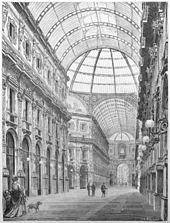
- September 15: In Milan , King Victor Emmanuel II opens the Galleria Vittorio Emanuele II shopping arcade named after him , a highlight of European arcade construction. Gaspare Campari , among others, opened his Caffé Campari here in the same year .
- The Haas House , built by August Sicard von Sicardsburg and Eduard van der Nüll for the carpet store Philipp Haas & Sons in the historicism style on Stock-im-Eisen-Platz in the city center of Vienna , the first large department store in Vienna, will be opened after a year of construction completed.
- Together with other women, Marie Remy and Clara Wilhelmine Oenicke found the Association of Artists and Art Friends in Berlin . Since women in the German Reich do not have legal capacity , male founding members are officially required, who are bound to the association through honorary membership without being full members. Despite its name, the association is geared towards the entire German-speaking area and the neighboring countries. For example, Marie Wiegmann from Düsseldorf also becomes a member of the association.
literature
- November 9: By law of the North German Confederation , all literary works whose authors died 30 or more years ago enter the public domain .
- November 10: With the volumes Faust I and Faust II by Johann Wolfgang von Goethe , the Reclam publishing house of the Leipzig publisher Anton Philipp Reclam begins publishing Reclam's universal library after the German Confederation has revised copyright law .
- Thérèse Raquin , Émile Zola's third novel, appears. The work brings the author's literary breakthrough in Paris.
- Leo Tolstoy completes the original version of his epic War and Peace , but it is not published.
- The historical novel Witiko by Adalbert Stifter is published.
music and theatre
- February 15: In the hall of the Dianabad in Vienna, the world premiere of the waltz On the beautiful blue Danube by Johann Strauss (son) takes place . The work is presented as a choral waltz by the Vienna Male Vocal Club and the Band of the 42nd Infantry Regiment, both conducted by Rudolf Weinwurm . The work hits with a bang and for the first time the term “ Schlager ” is used for it in the critics . Nevertheless, the waltz, the orchestral version of which will be performed for the first time on March 10, does not catch on at first.
- March 11: The first French version of Giuseppe Verdi's grand opéra Don Carlos , based on a libretto by Joseph Méry and Camille du Locle , is premiered in Paris. It is based on the play of the same name by Friedrich Schiller .
- April 12: The Paris Théâtre des Variétés premieres Jacques Offenbach 's opera -bouffe The Grand Duchess of Gerolstein with Hortense Schneider in the title role. The libretto of the operetta is by Henri Meilhac and Ludovic Halévy .
- April 27: The operetta Banditenstreiche by Franz von Suppè , which belongs to the golden era of operettas , has its world premiere at the Carltheater in Vienna.
- 27 April: Charles Gounod 's opera Roméo et Juliette premieres at the Théâtre-Lyrique in Paris .
- December 6: Her Majesty's Theater in London's Haymarket in the West End burns down.
- Timothy Daniel Sullivan authors the patriotic song God Save Ireland .
- Alexander Muir , a teacher who emigrated from Scotland to Canada, penned the patriotic song The Maple Leaf Forever .
society

- January 22: King Ludwig II of Bavaria and Princess Sophie in Bavaria , sister of Empress Elisabeth , announce their engagement. However, the planned wedding date in August is postponed several times and the engagement is finally broken at the end of the year. Meanwhile, Sophie begins an affair with the photographer's son Edgar Hanfstaengl .
- March 28: One of the first full-page illustrated open cards in Germany is sent out in Berlin. Another such precursor of the postcard will be sent from Wrocław on October 30th.
- 8 May: The Kursalon in Vienna's Stadtpark , built according to plans by Johann Garben in neo -Renaissance style , is opened. The building is intended to be used to serve medicinal water , amusements are expressly prohibited.
- July 21: The Belgian King Leopold II donates the Order of Civil Merit as a reward for many years of service to the state in municipal etc. offices, as well as for excellent, courageous and self-sacrificing actions and in general for outstanding deeds in the sense of general philanthropy .
- August 29: At the German Lawyers ' Conference in Munich, Karl Heinrich Ulrichs publicly calls for the impunity of same-sex sexual acts for the first time in a speech , since these are based on a natural predisposition, which leads to tumultuous scenes among the audience and the termination of his speech.
- October 12: In London, the sailing ship Hougoumont departs for Western Australia . On board are 279 convicts and 108 passengers. The Blackwall frigate carries out the final transport of convicts to the Australian penal colony .
- Scottish teacher Alexander Melville Bell introduces Visible Speech phonetic notation , intended to help deaf people learn spoken language.
- John Hamilton launches the Pachisi derivative Patcheesi on the American market.
religion
- 24 September to 28 September: First Lambeth Conference of the Anglican Church
disasters
- February 4: The Kefalonia earthquake completely destroys the town of Lixouri , while the south-eastern part and the north of the island are largely spared. There were several aftershocks in the following days. According to an official balance sheet, the earthquake in Argostoli and Lixouri killed 233 people, destroyed 3,200 houses and damaged another 2,600. After another tremor near Gythio in the Peloponnese , a tsunami on September 20 also devastated the town of Lixouri, badly hit by earlier tremors that year.
- June 29: Eight people are killed in the Warrington rail crash.
- July 1: A shaft ruptures in the Neue Fundgrube in Lugau in the Ore Mountains, killing 101 miners.
- October 29: The British passenger ship RMS Rhone sinks in a severe hurricane off Salt Island in the British Virgin Islands . At least 124 people die. According to the customs of the time, the passengers were tied to their beds so as not to fall out in the storm. The hurricane later became known as the San Narciso Hurricane and claimed a total of more than 800 lives.
- November 8: Two explosions occur at the Ferndale Colliery coal mine in Wales, killing 178 men and boys.
- Extremely cold weather leads to the peak of the famine in Finland and northern Sweden , the last naturally induced famine in Europe. About 15% of Finland's population dies.
Sports
- February 3: The Vienna Ice Skating Club is founded. The articles of incorporation submitted on February 7th will be approved on June 14th.
- June 19: The Belmont Stakes horse race in New York's Bronx is held for the first time.
- 9 July: Scotland's oldest football club, Glasgow 's Queen's Park FC , is formed.
- 27 July: William McLaren , Great Britain , runs the first time recorded in the men 's 100 meters (110 yards ) at 11 seconds.
- 4 September: Sheffield Wednesday Football Club is formed.
- December 8: About 100 men take part in the first one-day race in cycling .
- The Queensberry Rules of Boxing , designed by John Graham Chambers and named after John Sholto Douglas, 9th Marquess of Queensberry , are published.
Born
January February
- January 2: Wilhelm Schueffner , Dutch microbiologist and immunologist († 1949)
- January 3: Carl Arp , German landscape painter (died 1913)
- January 3: Elsa Asenijeff , Austrian writer († 1941)
- January 3: Erland Koch , German marksman (died 1945)
- January 4: Fritz Irmiger , Swiss customs officer (died 1926)
- January 8 Emily Greene Balch , US national economist, Nobel Peace Prize laureate (d. 1961)
- January 10: Gerhard Anschütz , German constitutional lawyer (died 1948)
- January 12: Alfred Forke , German sinologist (died 1944)
- January 14: James H. Hughes , American politician (died 1953)
- January 15: Eustachius Kugler , German Catholic monk of the Brothers of Mercy (died 1946)
- January 15: Maria Theresa of Naples-Sicily , Countess of Trani and Princess of Naples-Sicily (d. 1909)
- January 17 Carl Laemmle , German-American film producer (d. 1939)
- January 18 Rubén Darío , Nicaraguan writer and diplomat (died 1916)
- January 20 Jules Amiguet , Swiss Protestant minister and university teacher (died 1946)
- January 21: Ivan Ivanovich Krischanowski , Russian composer (died 1924)
- January 21: Ludwig Thoma , German writer (died 1921)
- January 21: Maxime Weygand , French general and politician in World Wars I and II (died 1965)
- January 24: Ernst Zahn , Swiss writer (died 1952)
- January 25: Simon Fraser Tolmie , Canadian politician (died 1937)
- January 27 Katherine Mayo , American writer and journalist (d. 1940)
- January 27: Claude Terrasse , French operetta composer (d. 1923)
- January 28 Albert Ahn , German publisher and industrialist (died 1935)
- January 29: Elisabeth Büchsel , German painter (died 1957)
- January 31 - Mariusz Zaruski , Polish general, yachtsman, mountaineer, writer, poet and painter (died 1941)
- February 1: Conrad Ramstedt , German physician (died 1963)
- February 5 – Elsbeth Krukenberg-Conze , German writer and women's rights activist (died 1954)
- February 6 Richard Lipinski , German trade unionist, politician and writer (died 1936)
- February 7 Laura Ingalls Wilder , American writer (died 1957)
- February 8: Michael Zeno Diemer , German painter (died 1939)
- February 8 Kirtland I. Perky , American politician (d. 1939)
- February 9 Edward W. Naylor , English organist, composer and music teacher (d. 1937)
- February 9: Natsume Sōseki , Japanese writer (died 1916)
- February 10: Charles W. Bryan , American politician (died 1945)
- February 10 Holm Olaf Bursum , American politician (died 1953)
- February 18 – Hedwig Courths-Mahler , German writer (died 1950)
- February 20 Dionisio Anzilotti , Italian jurist (died 1950)
- February 24 Karl Schönherr , Austrian dramatist (died 1943)
- February 25: Rudolf Tarnow , Low German writer (died 1933)
- February 26 – James Fairman Fielder , American politician (died 1954)
- February 27 Wilhelm Peterson-Berger , Swedish composer and music critic (d. 1942)
- February 28 – Thomas Theodor Heine , German painter, draftsman and satirist (died 1948)
March April
- March 1: Konrad Agahd , German writer, educator and journalist (died 1926)
- March 1: Porter H. Dale , American politician (died 1933)
- March 3 Gustav Strube , American composer (died 1953)
- March 5: Theodor Zöckler , Protestant pastor († 1949)
- March 8: Charles Engelhard , American industrialist (died 1950)
- March 8 Orus Jones , American golfer (d. 1963)
- March 10: Hector Guimard , French architect (died 1942)
- March 19: Philipp Fauth , German elementary school teacher and astronomer († 1941)
- March 21: Florenz Ziegfeld Jr. , was an American theater and film producer (d. 1932)
- March 25: John Gutzon de la Mothe Borglum , American sculptor (d. 1941)
- March 25: Arturo Toscanini , Italian conductor (died 1957)
- March 26: Johannes Rudolf Max Adler , German historian, literary scholar and educator († 1937)
- March 26 – Pilar Fernández de la Mora , Spanish pianist and music teacher (d. 1929)
- March 26: Albert Herzog , German writer, journalist, poet and storyteller (died 1955)
- March 28: Paul Ikier , Prussian lawyer, district administrator and manor owner († 1926)
- March 28: Ferruccio Cattelani , Italian composer (d. 1932)
- March 29 Cy Young , American baseball player (d. 1955)
- March 30: Paul Davidson , German film producer (died 1927)
- March 31: Elmer Ivan Applegate , American botanist (d. 1949)
- April 1: Paul Langhans , German geographer and cartographer (died 1952)
- April 1 Daniel Calhoun Roper , American politician (died 1943)
- April 2: Eugen Sandow , German founder of bodybuilding († 1925)
- April 4: Richard Adamík , Czech physician and moral idealist (died 1952)
- April 4 Victoria Cartier , Canadian organist and music teacher (d. 1955)
- April 4: Arnold Middendorf , official and cathedral provost in Cologne († 1930)
- April 5 Friedrich Schwendimann , Swiss Roman Catholic clergyman and church historian (died 1947)
- April 7: Hermann Adolf Wilhelm Aisch , German pastor and writer (died 1954)
- April 9 Wilhelm Lütgert , German Protestant theologian (died 1938)
- April 9: Chris Watson , Australian politician and Prime Minister (died 1941)
- April 11: William Edwin Haesche , American composer (d. 1929)
- April 13: Christoph March , German clergyman, pastor in Eschfeld († 1931)
- April 13 William Arundel Orchard (d. 1961) English-born Australian organist, conductor, composer and music educator
- April 14: Fannie Thomas , US age record holder (d. 1981)
- April 15: Max Sannemann , German composer and music teacher († 1924)
- April 16: Wilbur Wright , American aviator and airplane builder (d. 1912)
- April 18: Lluís Millet i Pagès , Catalan musician and composer (died 1941)
- April 19 James Cullen , Irish mathematician (died 1933)
- April 19 William Augustus Ayres , American politician (died 1952)
- April 22 Sir Littleton Ernest Groom , Australian politician (died 1936)
- April 23: Johannes Fibiger , Danish pathologist (died 1928)
- April 24: Karel Navrátil , Czech composer (died 1936)
- April 29: Knud Christian Andersen , Danish zoologist (died 1918)
May June
- May 7: Władysław Reymont , Polish writer (died 1925)
- May 8: Margarete Böhme , German writer (died 1939)
- May 8: Albert von Thurn und Taxis , German nobleman (died 1952)
- May 10: Samuel Robison , United States admiral; Commander-in-Chief of the US Fleet († 1952)
- May 10: Curtis D. Wilbur , American politician and lawyer (d. 1954)
- May 14 Kurt Eisner , German politician and writer (died 1919)
- May 15: Fredrik Hjalmar Johansen , Norwegian polar explorer (d. 1913)
- May 16: Jeanne Berta Semmig , German writer and poet (died 1958)
- May 17 Georgette Agutte , French painter (died 1922)
- May 17: Theodor Leipart , German trade unionist (died 1947)
- May 17 James Richardson Spensley , English doctor, football player and coach (d. 1915)
- May 19: Otto Appel , German phytomedicine (died 1952)
- May 22 Erich Lexer , German surgeon, co-founder of plastic surgery († 1937)
- May 25: Wilhelm Langheld , German officer (died 1917)
- May 25: John Stuchell Fisher , American politician (d. 1940)
- May 26: Friedrich Langewiesche , German educator, gymnast, collector, researcher, friend of homeland and nature († 1958)
- May 26: Maria von Teck , German-British noble (died 1953)
- May 27 Arnold Bennett , British novelist (died 1931)
- May 27: Hermanus Frederik Roll , Dutch physician (died 1935)
- May 28: Sebastian Rieger , Tyrolean folk poet and priest († 1953)
- May 29: Charles A. Rawson , American politician (died 1936)
- May 30: Fritz Binde , German preacher, evangelist (died 1921)
- May 31: Maria Josepha Luise of Saxony , mother of Emperor Charles I of Austria (died 1944)
- June 3: Franz Goldenberger , Bavarian Minister of Education († 1948)
- June 4: Eugen Abresch , German entrepreneur, inventor, art collector and politician (d. 1952)
- June 4 Gustaf Mannerheim , Finnish officer and statesman (died 1951)
- June 5: Max Warburg , German banker (died 1946)
- June 8: Dagny Juel , Norwegian novelist and playwright (d. 1901)
- June 8: Ernst Krieger , German chess problem composer (died 1943)
- June 8: Frank Lloyd Wright , American architect (d. 1959)
- June 9: Jules Bouver , French organist and composer (died 1911)
- June 10: Julius Meier-Graefe , German composer (died 1935)
- June 11: Charles Fabry , French physicist (died 1945)
- June 11: René Hanriot , French racing driver and aviation pioneer (d. 1925)
- June 11: Marie Krøyer , Danish painter (died 1940)
- June 12 Henry Pomeroy Davison , American banker, philanthropist (d. 1922)
- June 12: Sylvester Stieber , German officer and colonial official (d. 1914)
- June 17 – Ignaz Wilhelm Auspitzer , Austrian editor and screenwriter († 1931)
- June 17 Henry Lawson , Australian author and poet (d. 1922)
- June 21: William Brede Kristensen , Norwegian church historian (d. 1953)
- June 22: Eugen Diederichs , German publishing bookseller (died 1930)
- June 23: Robert Sterl , German painter (died 1932)
- June 28 Luigi Pirandello , Italian writer (died 1936)
July August
- July 1: William Albert Ashbrook , American politician (died 1940)
- July 1: Franz Boll , German classical philologist († 1924)
- July 1: Česlovas Sasnauskas , Lithuanian composer (died 1916)
- July 3: Johannes Hoffmann , Prime Minister of Bavaria (died 1930)
- July 5 Andrew Ellicott Douglass , American astronomer (d. 1962)
- July 5: Bernhard Schnackenburg , mayor of the Prussian city of Altona († 1924)
- July 6 – Joe Keaton , American vaudeville performer, film actor and acrobat, father of Buster Keaton (d. 1946)
- July 8: Käthe Kollwitz , German artist (died 1945)
- July 10: Maximilian von Baden , last Chancellor of the German Empire († 1929)
- July 11: John J. Cornwell , American politician (died 1953)
- July 11 Anton Griessen , Swiss supporter of the Antonians, specialist historian and biographer († 1925)
- July 12: Karl Aschoff , German pharmacist (died 1945)
- July 12 Angelo Maria Dolci , Italian Roman Catholic cardinal (died 1939)
- July 15: Jean-Baptiste Charcot , French scientist and polar explorer (died 1936)
- July 16 Richard Leutheußer , German politician (died 1945)
- July 17 Leo Jogiches , Polish-Jewish politician (died 1919)
- July 18 Molly Brown , American philanthropist, Titanic survivor (died 1932)
- July 18 Karl Voll , German art historian (died 1917)
- July 19: Guido von Pogatschnigg , Romanian-German composer, church musician and music teacher († 1937)
- July 23 Simeon S. Pennewill , American politician (died 1935)
- July 25: Max Dauthendey , German poet and painter (died 1918)
- July 27: Enrique Granados , Spanish composer and pianist (died 1916)
- July 28 Charles Dillon Perrine , American astronomer (died 1951)
- August 1 William Speirs Bruce , Scottish polar explorer and oceanographer (died 1921)
- August 1 Constantin Christomanos , Greek historian, playwright and theater director (died 1911)
- August 2: Johanne Dybwad , Norwegian actress (d. 1950)
- August 2: Frank A. Perret , American inventor, entrepreneur and volcanologist (d. 1943)
- August 3 - Stanley Baldwin , British politician and Prime Minister (died 1947)
- August 6 James Loeb , Jewish banker, philanthropist and patron (died 1933)
- August 7: Emil Nolde , German Expressionist painter (died 1956)
- August 10 Emil Oberhoffer , American conductor, composer and music teacher (d. 1933)
- August 12 Edith Hamilton , German-American writer (d. 1963)
- August 13 Rudolf G. Binding , German writer (died 1938)
- August 13: Arthur Eichengrün , German chemist (died 1949)
- August 13: François-Xavier Mercier , Canadian singer, music teacher and composer (d. 1932)
- August 14 John Galsworthy , British novelist (died 1933)
- August 14 Artur Oppman , Polish writer (died 1931)
- August 15: Anathon Aall , Norwegian philosopher (died 1943)
- August 15: Walter Robinow , German chess functionary (died 1938)
- August 18 – Hans Kloepfer , Austrian writer and dialect poet (died 1944)
- August 20: Rohan Koda , Japanese writer (died 1947)
- August 22: Guido Adolf Georg Dietlof von Arnim-Boitzenburg , Prussian politician (died 1933)
- August 22: Maximilian Oskar Bircher-Benner , Swiss doctor and nutritionist († 1939)
- August 22 Herbert E. Hitchcock , American politician (died 1958)
- August 22 Maud Powell , American violinist (d. 1920)
- August 28: Umberto Giordano , Italian composer (died 1948)
September October
- September 5: Amy Beach , American composer (d. 1944)
- September 6: Franciszek Brzeziński , Polish composer (died 1944)
- September 7: Albert Bassermann , German actor (died 1952)
- September 8 Alexander Parvus , Russian revolutionary (Menshevik) and German social democrat (died 1924)
- September 9: Ernst Oppler , German painter and etcher (died 1929)
- September 9: Felix von Dobschütz , German clergyman, pastor and superintendent in Silesia (died 1936)
- September 9: Max L. Strack , German ancient historian (died 1914)
- September 12 Herbert L. Clarke , American cornetist and composer (d. 1945)
- September 13: Ernst Platz , German mountain painter, illustrator and alpinist († 1940)
- September 15: Petr Bezruč , Czech writer and poet (died 1958)
- September 23 John Lomax , American folklore and musicologist (d. 1948)
- September 25: Augusto de Vasconcelos , Portuguese doctor, diplomat, politician, foreign minister and prime minister (died 1951)
- September 27 Giovanni Bonzano , Italian clergyman, Roman Catholic cardinal (died 1927)
- September 29: Walther Rathenau , German industrialist and politician (died 1922)
- October 1: Charles Edward Adams , American politician, Lieutenant Governor of Minnesota (d. 1936)
- October 2: Karl Armbrust , German painter (died 1928)
- October 2 Theodore F. Green , American politician (died 1966)
- October 2 – Fritz Held , German businessman and racing driver (died 1938)
- October 3 – Pierre Bonnard , French Symbolist painter (died 1947)
- October 5: Frank H. Hitchcock , American politician (died 1935)
- October 6: Václav Radimský , Bohemian-Czechoslovakian landscape painter (died 1946)
- October 7: Yevgeny Karlovich Miller , General in the Russian Civil War (died 1939)
- October 7 – Otto Anthes , German educator and writer (died 1954)
- October 7 Domenico Jorio , Italian clergyman, Roman Catholic cardinal (died 1954)
- October 8: Gottlieb Elster , German sculptor (died 1917)
- October 12 Giulio Serafini , Italian clergyman, Bishop of Pescia and cardinal of the Roman Catholic Church (died 1938)
- October 13 Ramón Maximiliano Valdés , President of Panama (d. 1918)
- October 14: Masaoka Shiki , Japanese poet (died 1902)
- October 15: Ferdinand Bronner , German novelist and playwright (died 1948)
- October 19 Paul Hey , German illustrator and graphic artist (died 1952)
- October 20 Ludwig Fahrenkrog , German poet and painter (died 1952)
- October 25: Józef Dowbor-Muśnicki , Polish general (died 1937)
- October 27: Thomas Walter Scott , Canadian politician (died 1938)
- October 28 – Hans Driesch , German biologist and natural philosopher (died 1941)
- October 29 Isidor Sadger , Austrian-Jewish physician and psychoanalyst (died 1942)
- October 30 – Ed Delahanty , American baseball player (d. 1903)
- October 31: Ludwig Radermacher , German classical scholar (died 1952)
November December
- November 1: Felix Hollaender , German writer and director (died 1931)
- November 1: Otto Lemm (manufacturer) , German entrepreneur († 1920)
- November 2: Richard Karutz , German doctor and ethnologist (died 1945)
- November 3: Wilhelm Kutta , German mathematician (died 1944)
- November 5 George Andrew Reisner , American Egyptologist (died 1942)
- November 6: Eduard Bernoulli , Swiss musicologist (died 1927)
- November 7: Marie Curie , Polish-French chemist and physicist (died 1934)
- November 8: Ilmari Krohn , Finnish composer and musicologist (died 1960)
- November 10: Gabriel Zelger , Swiss bishop (died 1934)
- November 13: Josefine Dora , Austrian actress (died 1944)
- November 14 Ottilie Pohl , German politician (died 1943)
- November 14: Friedrich Vollmer , German classical philologist (died 1923)
- November 15: Emil Krebs , German language genius (died 1930)
- November 16: William F. Kirby , American politician (died 1934)
- November 17 Anna Feldhusen , German painter and etcher (died 1951)
- November 19: John Møller , Greenlandic photographer, printer, interpreter, ornithologist, expedition member and provincial councilor (d. 1935)
- November 22 Wilhelm Groener , German military and politician (died 1939)
- November 22: Ernst Sachs , German inventor and industrialist (died 1932)
- November 26 Charles Albert Boynton , American lawyer (died 1954)
- November 26 Emil von Dungern , German physician (died 1961)
- November 27: Charles Koechlin , French composer (died 1950)
- November 27 Margaret Ruthven Lang , American composer (d. 1972)
- November 27: Hélène de Mandrot , Swiss artist, art collector and promoter of architectural and artistic modernism (d. 1948)
- November 28: James Richard Atkin , British jurist (d. 1944)
- November 28 – Felix Mader , German Roman Catholic priest, art historian and monument conservator (died 1941)
- November 30: Franz Ahlgrimm , German politician (died after 1919)
- December 1: Ignacy Mościcki , Polish scientist and politician (died 1946)
- December 1: Julian Michaux , Russian fencer (died 1925)
- December 1: Robert P. Lamont , American politician (died 1948)
- December 3 William John Bowser , Canadian politician (died 1933)
- December 5: Antti Aarne , Finnish fairy tale researcher (died 1925)
- December 5: Józef Piłsudski , Polish marshal and statesman (died 1935)
- December 6: August Leopold Philipp Maria Michael Gabriel Raphael Gonzaga , pretender to the throne of Brazil (d. 1922)
- December 7: Wenceslaus Straussfeld , German minister, advisor and election campaigner (died 1933)
- December 11: Heinrich Bulle , German archaeologist (died 1945)
- December 11: Antonio Conte , Italian fencer (died 1953)
- December 12: Anna Schieber , German writer (died 1945)
- December 13: Kristian Birkeland , Norwegian physicist (died 1917)
- December 15 – Edith Lucy Austin , British tennis player (d. 1953)
- December 16: Arthur Schloßmann , German pediatrician, founder of the first infant clinic († 1932)
- December 17: Johannes Maria Gföllner , Austrian clergyman, Catholic Bishop of the Diocese of Linz († 1941)
- December 17: Richard Kandt , German doctor and explorer of Africa (died 1918)
- December 20 William Heffelfinger , American football player (d. 1954)
- December 20: Fini Henriques , Danish composer and violinist (died 1940)
- December 21: Albert Trautmann , German pharmacist, local historian and writer († 1920)
- December 22: Joseph Maria Olbrich , Austrian architect (d. 1908)
- December 23: Jacob Astor , German politician (died 1938)
- December 24: Tevfik Fikret , Turkish poet (died 1915)
- December 25 Alfred Kerr , German writer, theater critic and journalist (died 1948)
- December 26: Julien Benda , French philosopher and writer (died 1956)
- December 27: Fredrik Stang , Norwegian politician and jurist (died 1941)
- December 27: Léon Delacroix , Belgian jurist and politician (died 1929)
- December 28: Charlotte Basté , German actress (died 1928)
- December 30: Henry S. Johnston , American politician (died 1965)
- December 31: Josef Feinhals , German entrepreneur (died 1947)
- December 31: Saitō Ryokuu , Japanese writer († 1904)
Exact date of birth unknown
- Alessandro Abate , Italian painter (died 1952)
- Josef Auer , German wood sculptor (died 1934)
- Gaston de Chasseloup-Laubat , French racing driver (died 1903)
- Eucarpio Espinosa , Chilean painter (died 1934)
- Florence Fuller , Australian painter (died 1946)
- David Solomonovich Schor , Russian-Jewish pianist and music teacher (died 1942)
- William E. Zeuch , American organist (died 1962)
Died
January
- January 2: Gottfried Heinrich Melzer , German bosser (porcelain mass shaper) at the Royal Meissen Porcelain Manufactory (b. 1820)
- January 2: Adolphe Noël des Vergers , French orientalist, archaeologist and epigraphist (b. 1805)
- January 2: Robert Miles Sloman , Anglo-German shipowner, theater operator and politician (b. 1783)
- January 4: John Fine , American jurist and politician (b. 1794)
- January 5: Carl Adam Kaltenbrunner , Austrian poet, writer and dialect researcher (b. 1804)
- January 5: Pierre-Benjamin Lafaye , French philosopher, linguist, Romance scholar and lexicographer (b. 1809)
- January 7: Dominik Gmür , Swiss politician (b. 1800)
- January 7: Arthur P. Hayne , American politician (b. 1788)
- January 7: Henri-Auguste-Georges de La Rochejaquelein , French military and politician (b. 1805)
- January 7: Johann Jakob Trog , Swiss politician and judge (b. 1807)
- January 8: Heinrich August Wilhelm Stolze , German stenographer (born 1798)
- January 9: Ludwig Helfft , German merchant and politician in Braunschweig (b. 1793)
- January 9: Karl Friedrich Sommer , German painter (b. 1830)
- January 9: Karl Wermuth , Chief of Police in the Kingdom of Hanover (b. 1804)
- January 10: Karl Moriz Diesing , Polish-Austrian helminthologist and botanist (b. 1800)
- January 10: William Turner , British diplomat (b. 1792)
- January 11: Marguerite-Joséphine Georges , French actress (b. 1787)
- January 11: Christoph von Kaufmann , German administrative lawyer (b. 1788)
- January 11: Karl Lange , German teacher, court stonemason, master mason and building contractor (b. 1811)
- January 12: Georg Merz , German optician (b. 1793)
- January 13: Antonio Maria Cagiano de Azevedo , Italian clergyman and cardinal of the Roman Church (b. 1797)
- January 13: Angelo Geniani , Italian Roman Catholic clergyman, Cistercian, abbot and abbot general (b. 1802)
- January 13: Franz Kirchgeßner , Baden jurist and civil servant (b. 1803)
- January 14: Samuel Chilton , American politician (born 1804)
- January 14: Victor Cousin , French philosopher and cultural theorist (b. 1792)

- January 14: Jean-Auguste-Dominique Ingres , French painter (b. 1780)
- January 15: Adolf Lohse , German architect and Prussian building official (b. 1807)
- January 17: Jacques-Amand Eudes-Deslongchamps , French physician, zoologist and paleontologist (b. 1794)
- January 17: Clément Villecourt , French cardinal and Bishop of La Rochelle from 1836 to 1856 (b. 1787)
- January 18: Hermann Askan Demme , German-Swiss physician (b. 1802)
- January 18: Hubert Félix Soyer-Willemet , French librarian and botanist (b. 1791)
- January 19: Johann Manschgo , Austrian painter (b. 1800)
- January 19: James Dixon Roman , American politician (b. 1809)
- January 20: Julia Bulette , American prostitute and pioneer (b. 1832)
- January 21: Joshua Alder , British zoologist (b. 1792)
- January 21: Julius Oeltzen , German Evangelical Lutheran minister (b. 1790)
- January 21: Anders Oldberg , Swedish educator and book author (born 1804)
- January 24: Nikolai Ivanovich Grech , Russian state councilor, author, linguist, literary critic and translator (b. 1787)
- January 24: Josef Laurent , German archivist and librarian (b. 1808)
- January 24: David Ritchie , American politician (b. 1812)
- January 25: Alexander CM Pennington , American politician (b. 1810)
- January 25: Josef Wintergerst , German painter (b. 1783)
- January 26: Johann Caspar Beeg , German technologist and publicist (b. 1809)
- January 26 Sarah Villiers, Countess of Jersey , English noblewoman (b. 1785)
- January 28: John J. Pettus , American politician, Governor of Mississippi (b. 1813)
- January 28: Franz Carl Weidmann , Austrian writer, actor and journalist (* 1787/1788)
- January 29: Philip Johnson , American politician (born 1818)
- January 30: Ezekiel F. Chambers , American jurist and politician (b. 1788)
- January 30: Jacob H. De Witt , American politician (b. 1784)
- January 30: Friedrich Kohlrausch , German pedagogue and Royal Hanoverian general school director (b. 1780)
- January 30: Kōmei , 121st Emperor of Japan (b. 1831)
February
- February 2: Washington Hunt , American politician, Governor of New York (b. 1811)
- February 3: Bonaventura von Brederlow , Prussian officer and traveling marshal of Duke Franz of Anhalt-Dessau (b. 1791)
- February 3: Maximilian zu Wied-Neuwied , German explorer, ethnologist and naturalist (b. 1782)
- February 4: Georg Friedrich Vorwerk , German merchant (b. 1793)
- February 5: Serafín Estébanez Calderón , Spanish writer (b. 1799)
- February 5: John Johnson , American politician (b. 1805)
- February 5: Philipp Hepp , German physician, botanist and lichen researcher (b. 1797)
- February 6: Salomon Munk , German orientalist (b. 1805)
- February 8: Michael August Wegelin , Swiss jurist and politician (b. 1797)
- February 9 Filippo De Filippi , Italian zoologist, museum director and explorer (b. 1814)
- February 9: Jacob G. Lauman , American businessman and military officer (b. 1813)
- February 10: Adolf von Morlot , Swiss geologist and prehistorian (b. 1820)
- February 10: Carl Wagner , German painter (b. 1796)
- 11 February: Gustav Senfft von Pilsach , Royal Saxon officer (b. 1790)
- February 11: Auguste Viquesnel , French traveller, geographer, meteorologist, ethnographer and geologist (b. 1803)
- February 12: Emilie Linder , Swiss painter and patron (b. 1797)
- February 13: Étienne Eggis , Swiss journalist and writer (b. 1830)
- February 13: Vincent Rumpff , Hamburg and Hanseatic diplomat (b. 1789)
- February 14: Eugen Wratislav von Mitrowitz , Austrian officer (b. 1786)
- February 15: Wojciech Cybulski , Polish literary historian and linguist (b. 1808)
- February 15: Franz Jahn , German medical officer, pharmacist and pomologist (b. 1806)
- February 16: Friedrich Wilhelm Christian Marburg , Hamburg merchant and member of parliament (b. 1803)
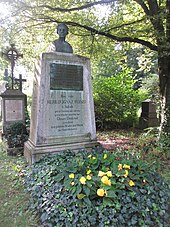
- February 16: Ignaz Perner , Bavarian lawyer and pioneer of the animal protection movement (b. 1796)
- February 17: Alexander Dallas Bache , American physicist (born 1806)
- 19 February: Stephan Franz Viktor , Archduke of Austria (b. 1817)
- February 22: Henry P. Alexander , American politician (b. 1801)
- 23 February: Werner-Constantin von Droste zu Hülshoff , member of the Westphalian provincial parliament, district deputy and landowner, member of the Order of Malta (b. 1798)
- February 23: George Thomas Smart , English conductor, organist, violinist and composer (b. 1776)
- February 24: Henry Wetherby Benchley , American politician, Lieutenant Governor of Massachusetts (b. 1822)
- February 24: Ludwig Bischoff , German educator, musician, critic and publisher (b. 1794)
- February 24: Isaac E. Holmes , American politician (b. 1796)
- February 26: Christian Morgenstern , German painter (b. 1805)
March
- March 1: Haubold von Einsiedel , German manor owner, deputy and district administrator (b. 1792)
- March 1: Frederick Henry Litchfield , Australian pastoralist, gold miner and explorer (b. 1832)
- March 2: Frans-Andries Durlet , Belgian architect, sculptor and printmaker (b. 1816)
- March 2: Franz Karl von Gemmingen , member of the Baden Estates Assembly and landlord in Rappenau (b. 1806)
- March 2: Aaron Ward , American officer, jurist and politician (b. 1790)
- March 3: Otto Baring , German physician and obstetrician in Hanover (b. 1806)
- March 3: William Czar Bradley , American politician (b. 1782)
- March 3: Johann Ludwig Lund , German-Danish painter (b. 1777)
- March 5: Clark B. Cochrane , American jurist and politician (b. 1815)
- March 5: Carl Gustaf Qvarnström , Swedish sculptor and painter (b. 1810)
- March 5: Eduard Simon , lawyer, senior judge and member of the bar association of the Kingdom of Hanover (b. 1805)
- March 6: Peter von Cornelius , German painter (b. 1783)
- March 6: Charles Farrar Browne , American novelist and satirist (b. 1834)
- March 6: John Goodsir , Scottish anatomist (b. 1814)
- March 6: József Hild , Hungarian architect and builder (b. 1789)
- March 6: Wiktor Każyński , Polish composer (b. 1812)
- March 7: Louis Boulanger , French painter (b. 1806)
- March 7: Carl Ludwig Gesell , Prussian organ builder (b. 1809)
- March 7: Therese aus dem Winckel , German painter, harpist and writer (born 1779)
- March 8: Caspar Kaltenmoser , German painter (b. 1806)
- March 9: Georg Michel , Swiss politician and judge (b. 1804)
- March 9: Sophie of Saxony , Duchess in Bavaria (b. 1845)
- March 10: Eduard Heinrich von Treitschke , Saxon lieutenant general (b. 1796)
- March 11: Moritz Rott , Bohemian theater actor and director (b. 1796)
- March 12: Carl Friedrich Metzler , German jurist and politician, member of the Frankfurt National Assembly (b. 1813)
- March 12: Friedrich Gottlieb Schulz , German teacher and member of the Frankfurt National Assembly (b. 1813)
- March 13: Josef Lonovics of Krivina , Bishop of Csanád and Archbishop of Kalocsa and Erlau (b. 1793)
- March 13: Luise Karoline of Hesse-Kassel , Duchess of Schleswig-Holstein-Sonderburg-Glücksburg (b. 1789)
- March 14: Albert Lester , American jurist and politician (b. c. 1803)
- March 16: Frederick of Hesse-Darmstadt , Imperial Russian Major General and Grand Ducal Hessian General (b. 1788)
- March 16: Emil Julius Carl Keßler , German entrepreneur and founder of Maschinenfabrik Esslingen (b. 1813)
- March 16: Friedrich Rumpf , Frankfurt architect (b. 1795)
- March 17: Wilhelm Baumgartner , Swiss choral conductor, pianist and composer (b. 1820)
- March 17: Friedrich Ludwig Effinger , Swiss politician, Mayor of Bern (b. 1795)
- March 17: Gabriel Güntner , German-Bohemian Premonstratensian canon and Catholic theologian (born 1804)
- March 17: Ludwig Häusser , German historian and politician (b. 1818)
- March 18: Heinrich Hellmuth von Hadeln , Nassau officer (b. 1796)
- March 19: August Abendroth , Hamburg lawyer, entrepreneur, land speculator and patron (b. 1796)
- March 19: Johann Lebrecht Eggink , Baltic German painter (b. 1784)
- March 19: Friedrich Fahrbach , Austrian composer and musician (b. 1809)
- March 21: Joseph Bailey , US Army Civil War brigadier general (b. 1825 or 1827)
- March 22: David Bebutov , Russian general of Armenian origin (b. 1793)
- March 22: Carl Emanuel Brunner , Swiss chemist (b. 1796)

- March 22: Julius Egghard , Austrian pianist and composer (b. 1834)
- March 23: Charles Deas , American painter (b. 1818)
- March 23: Gottfried Eisenmann , German physician, politician, political publicist and medical writer (b. 1795)
- March 24: John Decatur Barry , Confederate brigadier general in Civil War (b. 1839)
- March 25: Jakob Ignaz Hittorff , French architect of German origin (b. 1792)
- March 25: Friedlieb Ferdinand Runge , German chemist (b. 1794)
- March 27: Carl Emil Gedike , German physician and medical director of the Royal Prussian Nursing School at the Charité in Berlin (b. 1797)
- March 27: Prideaux John Selby , English ornithologist, botanist and artist (b. 1788)
- March 28: Ludwig Friedrich Hesse , German historian (b. 1783)
- March 29: George R. Riddle , American politician (b. 1817)
- March 31: Philipp Allmang , German evangelical clergyman and politician (b. 1799)
- March 31: Jean-Baptiste Fresez , Luxembourgish painter (b. 1800)
April
- April 1: Louis du Couret , French adventurer and travel writer (b. 1812)
- April 1: Hermann Schiff , German writer (b. 1801)
- 2 April: Christian Friedrich Stempel , Lower Sorbian pastor and poet (b. 1787)
- April 3: George Wythe Randolph , lawyer, brigadier general in the Confederate Army and Secretary of War of the Confederate States of America (b. 1818)
- April 6: George Evans , American politician (b. 1797)
- April 7: Joseph A. Gilmore , American politician, Governor of New Hampshire (b. 1811)
- April 8: Johann Rudolf Raschle , Swiss politician and industrialist (b. 1798)
- April 8: John Selden Roane , American politician, Governor of Arkansas (b. 1817)
- April 8: Emil Adolf Roßmäßler , German naturalist, politician and popular writer (b. 1806)
- April 9: Auguste Rougemont , Swiss jurist and politician (born 1798)
- April 12: Ottokar Maria von Attems , Prince-Bishop of Seckau and Apostolic Administrator of the Diocese of Leoben (b. 1815)
- April 12: William Bullock , American inventor (b. 1813)
- April 12: Johann Christian Friedrich Tuch , German orientalist and theologian (b. 1806)
- April 13: Karl von Franck , Austrian general and Minister of War (b. 1806)
- April 13: Johann Joseph Rosenbaum , German Catholic clergyman and theologian (b. 1798)
- April 14: Ernst Ferdinand Yxem , German classical philologist and high school teacher (b. 1799)
- April 17: George W. Chase , American politician (b. 1802)
- April 17: Theodor Mögling , German silk-maker, politician and revolutionary (b. 1814)
- April 18: Robert Smirke , British architect (b. 1780)
- April 19: Antoine-Joseph Jobert de Lamballe , French surgeon (born 1799)
- April 21: Xenophon Alexeyevich Polevoi , Russian journalist, writer, translator and literary critic (b. 1801)
- April 21: Romulus Mitchell Saunders , American politician (b. 1791)
- April 22: Alexander Dmitrievich Petrov , Russian chess player (b. 1794)
- April 22: Jean Elias Benjamin Valz , French astronomer (born 1787)
- April 24: Dimitrios Kallergis , Greek general and statesman (b. c. 1803)
- April 27: Kwaku Dua I Panyin , Asantehene (ruler) of Ashanti Kingdom (b. c. 1797)
- April 29: Achilles Bischoff , Swiss politician (b. 1795)
- April 30: Georg Christoph Gack , Bavarian MP, clergyman and author (b. 1793)
May
- May 1: Johann Martin Morat , German painter and lithographer (born 1805)
- May 1: Karl Sintenis , German classical philologist and teacher (b. 1806)
- May 2: Samuel G. Hathaway , American jurist and politician (b. 1780)
- 3 May: Leopold Pelldram , Bishop of Trier (b. 1811)
- May 3: Fanny Tacchinardi-Persiani , Italian opera singer (b. 1807)
- May 5: Walter Crum , Scottish chemist and entrepreneur (b. 1796)
- May 5: Mace Moulton , American politician (b. 1796)
- May 5: Philippe Parmentier , Belgian sculptor (b. 1787)
- May 6: Johann Kaspar Aiblinger , German composer and Kapellmeister (born 1779)
- May 6: Hermann Schievelbein , German sculptor (b. 1817)
- May 8: Elijah Hise , American politician (born 1802)
- May 9: Jacques-Joseph Champollion , French archaeologist and librarian (born 1778)
- May 10: Heinrich Beitzke , German military writer (b. 1798)
- May 11: Johann Friedrich Hermann Albers , German physician and pathologist (b. 1805)
- May 11: Joseph A. Wright , American politician, Governor of Indiana (b. 1810)
- May 12: Eduard Gerhard , German classical archaeologist (b. 1795)
- May 17: Julius Léopold Eduard Avé-Lallemant , German botanist (b. 1803)
- May 17: Johann Anton Steinegger , Swiss politician and banker (b. 1811)
- May 18: Clarkson Stanfield , English stage and fine art painter (b. 1793)
- May 20: Franz Oliver von Jenison-Walworth , Bavarian politician and diplomat (b. 1787)
- May 21: Johann Heinrich Meidinger , German merchant, geographer and travel writer (born 1792)
- May 22: Edward Hodges Baily , British sculptor (b. 1788)
- May 25: Aloise Kettel , Austrian actress (b. 1803)
- May 25: Wilhelm von Kügelgen , German painter, writer and chamberlain at the ducal court of Anhalt-Bernburg (b. 1802)
- May 27: Thomas Bulfinch , American banker and writer (b. 1796)
- May 29 Carlos de Morais Camisão , Brazilian military (b. 1821)
- May 30: Ramón Castilla , Peruvian military and politician, President of Peru (b. 1797)
- May 31: Théophile-Jules Pelouze , French chemist (b. 1807)
- May: Kunta Haji Kizhiev , Kumyk sheikh and founder of a new Sufi movement (b. c. 1830)
June
- June 1: Karl von Staudt , German mathematician (b. 1798)
- June 3: Richard Spaight Donnell , American politician (b. 1820)
- June 6: Mathilde Marie Adelgunde Alexandra , Archduchess of Austria (b. 1849)
- June 7: Athanasios Miaoulis , Greek politician, Prime Minister of Greece (b. 1815)
- June 9: Louis Bötticher , German opera singer (b. 1813)
- June 9: Bruno von Natzmer , Prussian mercenary leader and Inspector General of the Nicaraguan Army (b. 1831)
- June 9: Christian Pløyen , Danish jurist and government official (born 1803)
- June 11 Karl Otto Weber , German surgeon and pathologist (b. 1827)
- June 12: Louis-Hippolyte Lebas , French architect (b. 1782)
- June 14: Jean Vidal , French violinist and conductor (b. 1789)
- June 15: Johann Hermann Carmiencke , German landscape painter (b. 1810)
- June 16: Paulus Modestus Schücking , German judge, bailiff, philosopher and man of letters (b. 1787)
- June 17: José Miguel Arroyo , Mexican Ambassador and Minister of Foreign Affairs (b. 1810)
- June 17: John Moore , American politician (b. 1788)
- June 19: Henry Dodge , American politician, Governor of the Wisconsin Territory (b. 1782)
- June 19: Maximilian I , Austrian Archduke and Emperor of Mexico (b. 1832)
- June 19: Tomás Mejía , Imperial Mexican general (b. 1820)
- June 19: Miguel Miramón , Imperial Mexican general (b. 1832)
- June 20 Ferdinand Gottlieb Flechtner , German textile manufacturer (b. 1811)
- June 23: Christian Georg Theodor Ruete , German ophthalmologist (born 1810)
- June 23: Armand Trousseau , French internist (b. 1801)
- June 25: Wilhelmine von Sydow , German writer (b. 1789)
- June 25: Christian Wilbrandt , Mecklenburg Germanist and politician (b. 1801)
- 26 June: Maximilian Anton , Hereditary Prince of Thurn and Taxis (b. 1831)
- June 28: Friedrich Günther , Prince of Schwarzburg-Rudolstadt, Count of Hohnstein, Lord of Blankenburg,leuteberg etc. (b. 1793)
- June 29: John Rutter Chorley , British author, bibliophile, Romance scholar and Hispanist (b. 1807)
- June 30: Peter Geist , Lower Franconian painter (b. 1816)
- June: Diego José Benavente y García de Bustamante , Chilean politician and member of the government junta (b. 1790)
July
- July 1: Thomas Francis Meagher , Irish freedom fighter, American politician, Governor of Montana Territory (born 1823)
- July 2: Friedrich Gustav Habel , German private scholar, archivist, castle researcher and provincial Roman archaeologist (b. 1792)
- July 3: Lazarus W. Powell , American politician, Governor of Kentucky (b. 1812)
- July 5: Karl Johan Andersson , Swedish adventurer, explorer, trader and travel writer in South West Africa (b. 1827)
- July 5: Caleb Claiborne Herbert , American plantation owner, officer and politician (b. c. 1814)
- July 5: Philipp Furtwängler , German organ builder (b. 1800)
- July 5 – James Moore Wayne , American jurist, politician and Supreme Court Justice (b. 1790)
- July 6: Karl von Enhuber , Bavarian painter (b. 1811)
- July 7: John Alsop King , American politician, Governor of New York (b. 1788)
- July 7: François Ponsard , French playwright (b. 1814)
- July 11: Henry LXVII. , Prince Reuss younger line (* 1789)
- July 12: Horatio McCulloch , Scottish landscape painter (b. 1806)
- July 12: Patricio Rivas , Nicaraguan lawyer and Supremo Director (head of state) of Nicaragua (b. c. 1810)
- July 15: Karl Friedrich von Below , Baltic nobleman and vice-governor in the governorate of Estonia (b. 1794)
- July 15 Rudolph Melchior , German-American craftsman, painter and flautist (b. 1836)
- July 18: Alfred Wells , American lawyer and politician (b. 1814)
- July 20: Jacob Erdman , American politician (b. 1801)
- July 21: Antonio Barezzi , Italian merchant and patron (b. 1787)
- July 23: Carlos Salazar Castro , Jefe Supremo of the Province of El Salvador and the Province of Guatemala in the Central American Confederation (b. 1800)
- July 26: Stephan Kellner , German glass painter (b. 1812)
- 26 July: Otto I , King of Greece (b. 1815)
- July 30: Richard Clauselle Puryear , American politician (b. 1801)
- July 31: Elisabeth Alphonsa Maria Eppinger , German Catholic religious founder (b. 1814)
- July 31: Benoît Fourneyron , French engineer and inventor (b. 1802)
- July 31: Rudolf Wäffler , Swiss politician (b. 1804)
August
- August 1: Christian Wilhelm Lindemann , German jurist and politician (b. 1798)
- August 3 August Boeckh , German philologist and archaeologist (b. 1785)
- August 4: Emil Cauer the Elder , German sculptor (b. 1800)
- August 4: Phan Thanh Gian , Vietnamese politician, historian, Neo-Confucian philosopher and diplomat (b. 1796)
- 4 August: Faustin Soulouque , President as well as Emperor of Haiti as Faustin I (b. 1782)
- August 6: David Rittenhouse Porter , American politician, Governor of Pennsylvania (b. 1788)
- August 7: Ernst Glüer , German architect (b. 1831)
- August 7: Ernst Otto Lindner , German musicological writer and journalist (b. 1820)
- August 8: Sarah Austin , British novelist and translator (b. 1793)
- August 8: Maria Theresa of Austria , Queen of the Two Sicilies (b. 1816)
- August 8: James Wilson , American politician (b. 1825)
- August 10: André Durand , French painter, draftsman and lithographer (b. 1807)
- August 16: Joseph Ambrosius Geritz , German clergyman, Bishop of Warmia (b. 1783)
- August 16 Friedrich Haase , German classical scholar (b. 1808)
- August 16: Johann Heinrich Deinhardt , German educator (b. 1805)
- August 17: Johann Heinrich Ammann , Swiss jurist and politician (b. 1820)
- August 18: Alexis Paccard , French architect (b. 1813)
- August 19: William B. Campbell , American politician, Governor of Tennessee (b. 1807)
- August 21: Juan Álvarez Benítez , President of Mexico (b. 1790)
- August 22: Manuel José Errazquin y Larrañaga , Uruguayan politician (b. 1801)
- August 23: Auguste-Marseille Barthélemy , French poet (b. 1796)
- August 24: Thomas Brown , American politician, Governor of Florida (b. 1785)
- August 25: Michael Faraday , English physicist and chemist (b. 1791)
- August 26: Pedro Martínez López , Spanish Romance scholar, Hispanist, grammarian and lexicographer (b. 1797)
- August 28: William A. Bradley , American politician, Mayor of Washington D.C. (b. 1794)
- August 28: Carl Mittermaier , German jurist, publicist and politician (b. 1787)
- August 30: John McQueen , American politician (born 1804)
- August 31: Charles Baudelaire , French poet (b. 1821)
September
- September 1: Edward Hodges , American organist and composer (b. 1796)
- September 1 Opanas Markevych , Russian-Ukrainian folklorist, ethnologist, social activist and member of the Brotherhood of Cyril and Method (b. 1822)
- September 3: James A. McDougall , American jurist and politician, attorney general for the states of Illinois and California (b. 1817)
- September 3: Heinrich Smidt , German writer (b. 1798)
- September 4: Henriette Méric-Lalande , French opera singer (b. 1798)
- September 5: Santiago Derqui , President of Argentina (b. 1809)
- 5 September: Wilhelm von Hessen , titular Landgrave of Hessen-Kassel and Governor of Copenhagen (b. 1787)
- 7 September: Franz von Stengel , German administrative officer (b. 1811)
- 7 September: Alexandru Sterca Șuluțiu , Romanian Greek Catholic Archbishop of Făgăraș and Alba Iulia (b. 1794)
- September 8: John L. Helm , American jurist and politician, Governor of Kentucky (b. 1802)
- September 9 Julius Kröhl , German-American engineer and submarine designer (b. 1820)
- September 10: Simon Sechter , Austrian music theorist, music teacher, organist, conductor and composer (b. 1788)
- 13 September: Friedrich Gerst , German Roman Catholic priest, prison chaplain and Düsseldorf original (b. 1805)
- 15 September: Wilhelm Heinrich Friedrich von Kleist , Prussian officer (b. 1785)
- September 20: Johann Adam Hartung , German classical scholar (b. 1801)
- 23 September: Pedro Nolasco Vergara Albano Chilean deputy , governor and landowner (b. 1800)
- September 25: Giuseppe Natoli , Italian statesman and patriot, leading figure in the Risorgimento (b. 1815)
- September 26: James Ferguson , Scottish engineer and astronomer (b. 1797)
- September 27: Albert Auguste Perdonnet , French engineer and railway pioneer (b. 1801)
- September 29: Sterling Price , American politician (b. 1809)
- 30 September: Johann Evangelist Engesser , Baden Roman Catholic clergyman and politician (b. 1778)
- September 30: Jeremiah Russell , American politician (b. 1786)
- September: Philoxène Boyer , French writer (b. 1829)
October
- October 3 – Anthony Martin Branch , American jurist and politician, officer in the Confederate Army (b. 1823)
- October 3 Elias Howe , American manufacturer and inventor (b. 1819)
- October 3: Thomas Estes Noell , American politician (b. 1839)
- 4 October: Johann Christian Gentz , German cloth maker, merchant and peat-cut owner (b. 1794)
- October 4: Eduard Kley , German preacher and educator, pioneer of Reform Judaism (b. 1789)
- October 5: Louis Henry Fontane , German pharmacist and father of the writer Heinrich Theodor Fontane (b. 1796)
- October 5: Achille Fould , French financier and statesman (b. 1800)
- October 5: Thomas Tagesbeck , German violinist, conductor and composer (b. 1799)
- October 7: Mohammed Afzal Khan , Emir of Afghanistan (b. 1811)
- October 7: Henry Timrod , American poet and journalist in the Confederacy (b. 1828)
- October 8: Johann Baptist Rousseau , German poet, journalist and editor (b. 1802)
- October 9: Ignacy Feliks Dobrzyński , Polish pianist and composer (born 1807)
- October 9: Abraham Mapu , Baltic-Russian Hebrew writer (b. 1808)
- October 10: Julius Mosen , German poet and writer (b. 1803)
- October 11: Christian Carl von Glück , German judge, politician, poet and art collector (b. 1791)
- October 11: David L. Seymour , American jurist and politician (b. 1803)
- October 12: Johann Ernst Dubois , German master tin caster and entrepreneur (b. 1805)
- October 12: Franz Xaver Haimerl , Austrian lawyer and university lecturer (b. 1806)
- October 14: Carlo Filangieri , Italian general (b. 1784)
- October 14: WO von Horn , German Protestant pastor and writer (b. 1798)
- October 16: Michael Hutchinson Jenks , American politician (b. 1795)
- 21 October: Georgi Rakovsky , Bulgarian revolutionary, ideologue, politician, writer, enlightener and activist of the Bulgarian National Revival (b. 1821)
- October 22: Eugène Millon , French chemist and physician (b. 1812)
- October 23: Franz Bopp , German linguist and Sanskrit researcher (b. 1791)
- 25 October: Georg Kestner , German archivist, banker and collector of works of art and autographs (b. 1774)
- October 25: Salamah III. , Metropolitan of the Ethiopian Orthodox Church
- October 28: Jakob Ferdinand Schreiber , German publisher (b. 1809)
- October 29 Matthias Franz Borgnis , German banker, jeweler and tobacco manufacturer (b. 1798)
- October 30: John Albion Andrew , American politician, Governor of Massachusetts (b. 1818)
- 31 October: William Parsons, 3rd Earl of Rosse , Irish astronomer (b. 1800)
November
- November 3: Segundo Ruiz Belvis , Puerto Rican independence fighter and abolitionist (b. 1829)
- November 3 Domitília de Castro Canto e Melo , Brazilian countess and mistress of Emperor Pedro I (b. 1797)
- November 5: Leopoldo O'Donnell , Spanish general and politician, President of the Spanish Government, Count of Lucena and Duke of Tetuán (b. 1809)
- November 7: Oronzio Gabriele Costa , Italian zoologist and entomologist (born 1787)
- November 10: Ludwig Foltz , German architect, sculptor and illustrator (b. 1809)
- November 11: Friedrich August Bouterwek , German history painter (b. 1806)
- November 12: Charles Frédéric Dubois , Belgian naturalist (b. 1804)
- November 13: Nathaniel Bullock , American politician, Lieutenant Governor of Rhode Island (b. 1779)
- November 13: Adolphe-Napoléon Didron , French archaeologist (b. 1806)
- November 14: Jacques Charles Brunet , French bibliographer and bookseller (born 1780)
- November 14: Julius Campe , German publisher (b. 1792)
- November 14: Friedrich Theodor Fischer , German architect and Baden building official (b. 1803)
- November 18: August Zierfuss , German needleman and entrepreneur (b. 1803)
- November 19: Fitz-Greene Halleck , American poet (b. 1790)
- November 20: Theodor Apel , German writer and benefactor (b. 1811)
- November 20: Peter Clodt von Jürgensburg , Russian sculptor (b. 1805)
- November 21: José Longinos Ellauri , Uruguayan jurist and politician (b. 1789)
- November 22: Ludwig von Stainlein , Bavarian count, composer and cellist (b. 1819)
- November 25: Karl Ferdinand Sohn , German painter (b. 1805)
- November 26: Hermann Adam von Kamp , German teacher, local historian and writer (born 1796)
- November 26: August Müller , German double bass player (b. 1808)
- November 27: Reuben H. Walworth , American jurist and politician (b. 1788)
- November 28: Caroline Klauhold , German portrait, genre and landscape painter (b. 1812)
- November 28: John Drake Sloat , US naval officer and politician, Military Governor of California (b. 1781)
December
- 1 December: Philaret Drozdov , Metropolitan of Moscow (b. 1783)
- December 6: Julius Ludwig Klee , German educator and linguist (b. 1807)
- December 6: Giovanni Pacini , Italian opera composer (b. 1796)
- December 7: Franz Josef Dobiaschofsky , Austrian painter (b. 1818)
- December 8: Alphonse Boilly , French engraver and lithographer (born 1801)
- December 9 Rudolf von Arthaber , Austrian textile manufacturer, art collector and patron (b. 1795)
- December 9: Johann Nikolaus von Dreyse , German inventor, designer and entrepreneur (b. 1787)
- December 9: Sigismund Stern , German-Jewish educator and writer (b. 1812)
- December 10: Sakamoto Ryōma , Japanese samurai and reformer (b. 1836)
- December 10: Edward Whelan , Canadian politician and journalist (b. 1824)
- December 11: William Brooks , British architect (b. 1786)
- 11 December: Wilhelm Felsche , German confectioner, chocolate manufacturer and coffeehouse founder in Leipzig (b. 1798)
- December 13: Artur Grottger , Polish painter and draftsman (b. 1837)
- December 18: Ferdinand Deycks , German classical scholar (b. 1802)
- December 19: Johann Georg Kastner , Franco-German composer and writer on music (b. 1810)
- December 21 Karl Friedrich Schimper , German naturalist, botanist and geologist (b. 1803)
- December 21: Robert Smith , American politician (b. 1802)
- December 22: Jacob Jacobsen Dampe , Danish politician (b. 1790)
- December 22: John W. Dana , American politician, Governor of Maine (b. 1808)
- December 22: Cornelius S. Hamilton , American politician (b. 1821)
- December 22: Jean-Victor Poncelet , French mathematician, engineer and physicist (b. 1788)
- December 22: Théodore Rousseau , French painter and founder of the Barbizon school (b. 1812)
- December 24: Amasa Dana , American politician (b. 1792)
- December 25: Toni Adamberger , Austrian actress (b. 1790)
- December 25: Jonah Sanford , American lawyer and politician (b. 1790)
- December 26: József Kossics , Hungarian-Slovene writer, poet, historian, folklorist and Catholic priest (b. 1788)
- 30 December: Franz von Lehrer , Tyrolean poet, jurist and politician and member of the Frankfurt National Assembly (b. 1775)
Exact date of death unknown
- Sarah Glover , English vicar's daughter and principal of a Sunday school (born 1785)
- Francesc Daniel Molina i Casamajó , Catalan architect (born 1812)
web links
- Digitized newspapers from 1867 in the newspaper information system (ZEFYS) of the Berlin State Library
- Austrian newspapers of the year 1867 in AustriaN Newspaper Online (ANNO) of the Austrian National Library





